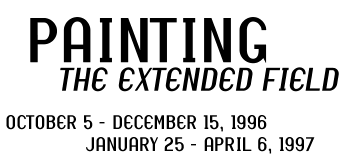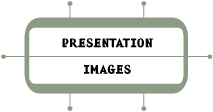
The position of painting has been the subject of ongoing debate virtually since the end of the nineteenth century when photography emerged as a strong competitor in the depiction of reality. Not until the 1960's and the first signs of the disintegration of modernism, however, did today's debate become visible in embryonic form. This debate has largely centered on the concepts of life and death. The fact that it came to be couched in such drastic terms has its roots in the late modernist notion which found its most significant expression in Clement Greenberg's representational world. The basic tenet of his theory was that, during its golden era, modernism had reduced everything which was not aesthetic in order to express the pure essence. As a result of this process of reduction, modernist painting eventually found itself in a blind alley in which internal issues became increasingly esoteric. All that remained was an interest in the minutia of painting, where every decision about the thickness of the stretcher or the size of the grain of the canvas assumed the proportion of important artistic decisions. What else could be reduced to allow painting to preserve its aesthetic immunity? In spite of the collapse of modernism, the question does not appear to have been conclusively settled: painting is often described as an endangered art form which must be kept uncontaminated by the chaotic multifariousness of contemporary reality in order to preserve its specific character or essence. Very few believe today that painting will survive only as an institutionalized relic of the modernist era. There is faith in painting as a flexible practice which must reject its internal concerns in order to be renewed.
This has meant that attention has shifted from the limitations of painting to its possibilities. This is especially evident in a number of exhibitions during the last few years: Unbound - Possibilities in Painting (Hayward Gallery, London 1994), Pittura Immedia - Malerei in den 90er Jahren, (Neue Galerie am Landesmuseum, Joanneum, Graz, 1995), Das Abenteuer der Malerei -Eine Reise in die Bildkunst der neunziger Jahre. (Württembergischer Kunstverein, Stuttgart and Kunstverein für die Rheinlände und Westfalen, Düsseldorf,1995), Des Limites du tableau - les possibles de la peinture (Museé départemental de Rochechouart, 1995), Painting Outside Painting - 44th Biennial Exhibition of Contemporary American Painting, (Corcoran Gallery of Art, Washington 1995-96).
These exhibitions have varied in ambition - from a kind of "state of painting" which would provide an overview of the multifaceted expression of contemporary painting, to organizers who have been content with pursuing a "one-liner", a theory of limited scope with a certain resemblance to the manifested image of the modernist era which promotes a certain stylistic direction or painterly attitude. In neither form do we recognize the situation of painting today. It therefore seemed important to put together an exhibit whose ambition lay somewhere in between these two extremes.
In working with this exhibition, the selection of artists was given top priority. It is interesting to note that this has resulted in a large number of different artistic points of departure which all have their equivalent in the contemporary state of art. Based on this, we arrived at several conclusions.
- that painting is no longer characterized by the same heroic and male aura as during the heyday of modernism; in today's painting, the female contingent is every bit as important as the male
- that the American-European axis, which dominated painting in the modernist era no longer reigns supreme; the exhibition suggests a geographic diversity that includes representatives from virtually every part of the world
- that the contemporary extensions of painting - be it in content or in choice of medium - is not a generational issue. We find that the artists included represent a large generation span. The oldest participant, Imi Knoebel, was born in 1940, and the youngest, Abigail Lane, in 1967.
Our exhibit is neither an attempt to create an overview of the situation of contemporary painting nor to insist on the validity of a certain theory in this regard. Instead, we want to highlight a special, and limited, set of problematic issues. The title of the exhibition describes these issues as an extended field which embraces two different aspects. One is an extension of painting's traditional means of expression, which includes methods not normally thought of as pertaining to painting. We are talking about artists who work within photography, video, sculpture, performance, printmaking, drawing, and installation. The inclusion of these media in an exhibition devoted to painting does not imply that we think that painterly practice is obsolete. Quite the contrary: we want to point to a mutual dependence, especially palpable in several of the exhibited artists who apply decidedly painterly practices in their work. The other extension is indicative of an interest in the contents of painting which runs counter to the modernist notion that all painting is basically about painting. Today, we find a painting that has pushed the limits of its contents far beyond aesthetics or other internal painterly issues. Painting has become a surface against which are projected a wide variety of different referential knowledge systems which comprise areas as different as the meta-language of painting, societal, social and ideological attitudes, as well as questions of individual and national identity.
It is in the cross-fertilization between the extension of medium and contents that we find an explanation of why it is that painting has not become defunct as an art form, but is still very much alive, carrying within itself the potential for renewal.
For reasons of space, these two aspects of the state of contemporary painting has been divided into two segments: one at Magasin 3 in Stockholm and one at the Rooseum in Malmö. This does not imply that they should be seen as two separate exhibits, but rather as a single one which the public in Stockholm and Scania may view in different chronological order without in any way affecting the totality of the experience. Nor will the difference in exhibition space between the Rooseum and Magasin 3 alter the fundamental character of the exhibit, but may possibly be seen as a bonus for those who have the opportunity to see all four shows.
The exhibition was produced within a brief period of intense activity. It has placed great demands on the participating artists, whose vast energy and enthusiasm helped make it possible. This also applies to the lenders who have been extremely generous and accomodating. Our heartfelt thanks also go to Sven-Olov Wallenstein, whose essay has provided a foundation for the exhibit. Our very special thanks, finally, to the staff of Magasin 3 and the Rooseum who helped this exhibition become reality.
DAVID NEUMAN
Magasin 3 Stockholm Konsthall
BO NILSSON
The Rooseum
-
PAINTING - The Extended Field October 5 - December 5, 1996.
Participating artists: Uta Barth, Paul McCarty, Luc Tuymans, Rémy Zaugg, Diana Thater, Rudolf Stigler, Jessica Stockholder.
-
PAINTING - The Extended Field January 25 - April 6, 1997.
Participating artists: Imi Knoebel, Nahum Tevet, Jutta Koether, Yukinori Yanagi, Polly Apfelbaum, Abigail Lane, Guillermo Kuitca.





 Rémy Zaugg: Not Here.
Rémy Zaugg: Not Here. Uta Barth: Ground #41. Ground #42.
Uta Barth: Ground #41. Ground #42. Luc Tuymans: The Rabbit.
Luc Tuymans: The Rabbit. Diana Thater: Late and Soon (Occident Trotting).
Diana Thater: Late and Soon (Occident Trotting). Rudolf Stingel: Untitled.
Rudolf Stingel: Untitled. Jessica Stockholder: #203.
Jessica Stockholder: #203. Paul McCarthy: Red Painter Drawing.
Paul McCarthy: Red Painter Drawing. Paul McCarthy: Painter.
Paul McCarthy: Painter. Polly Apfelbaum: Eclipse.
Polly Apfelbaum: Eclipse. Jutta Koether: frontage: well, show me nothing.
Jutta Koether: frontage: well, show me nothing. Abigail Lane: Bloody Wallpaper. Broken Heart.
Abigail Lane: Bloody Wallpaper. Broken Heart. Yukinori Yanagi: Four China.
Yukinori Yanagi: Four China. Nahum Tevet: Untitled.
Nahum Tevet: Untitled. Yukinori Yanagi: Wandering Position.
Yukinori Yanagi: Wandering Position. Imi Knoebel: Grace Kelly VII-3.
Imi Knoebel: Grace Kelly VII-3. Guillermo Kuitca: Mozart da Ponte III.
Guillermo Kuitca: Mozart da Ponte III.
![]()